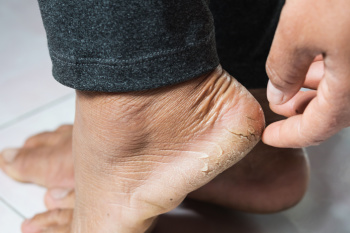
Cracked heels occur when the skin around the heels becomes dry, thickened, and fissured. This condition is often caused by a lack of moisture, leading to the skin's inability to retain hydration and elasticity. While anyone can develop cracked heels, some individuals are at a higher risk. Those who frequently expose their feet to harsh conditions, such as prolonged standing, walking barefoot, or wearing open-back shoes, are more susceptible. Additionally, factors like obesity, diabetes, and aging can contribute to the development of cracked heels. Symptoms of cracked heels include dryness, flakiness, redness, itching, and the formation of deep cracks or fissures. These fissures can be painful and may bleed in severe cases. It is essential to address cracked heels promptly to prevent complications such as infections. If you have developed cracked heels, it is strongly suggested that you consult a podiatrist who can provide the appropriate treatment methods.
Cracked heels are unsightly and can cause further damage to your shoes and feet. If you have any concerns, contact one of our podiatrists from Lovely Foot Associates, PC. Our doctors can provide the care you need to keep you pain-free and on your feet.
Cracked Heels
Cracked heels appear unappealing and can make it harder for you walk around in sandals. Aside from looking unpleasant, cracked heels can also tear stockings, socks, and wear out your shoes. There are several methods to help restore a cracked heel and prevent further damage.
How Do You Get Them?
Dry skin is the number one culprit in creating cracked heels. Many athletes, walkers, joggers, and even swimmers suffer from cracked heels. Age and skin oil production play a role to getting cracked heels as well.
Promote Healing
Over the counter medicines can help, especially for those that need instant relief or who suffer from chronic dry feet.
Wear Socks – Wearing socks with medicated creams helps lock in moisture.
Moisturizers – Applying both day and night will help alleviate dryness which causes cracking.
Pumice Stones – These exfoliate and remove dead skin, which allows for smoother moisturizer application and better absorption into the skin.
Change in Diet
Eating healthy with a well-balanced diet will give the skin a fresh and radiant look. Your body responds to the kinds of food you ingest. Omega-3 fatty acids and zinc supplements can also revitalize skin tissue.
Most importantly, seek professional help if unsure how to proceed in treating cracked heels. A podiatrist will help you with any questions or information needed.
If you have any questions, please feel free to contact our office located in Johnstown, PA . We offer the newest diagnostic and treatment technologies for all your foot care needs.